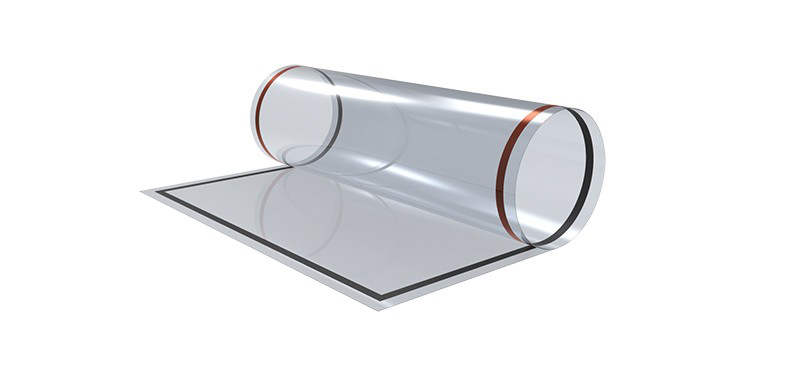2025-07-22
With the rapid advancement of energy vehicle (EV) technology, the requirements for material performance are constantly increasing. Metal mesh transparent conductive films (TCFs), as a key material combining high light transmittance with excellent conductivity, are playing an indispensable role throughout the NEV ecosystem. Whether in intelligent windows, display interaction, safety control, or energy harvesting, TCFs are crucial for enhancing the vehicle’s overall intelligence, safety, and efficiency.
Smart Dimming Windows
Metal mesh TCFs are critical components in smart dimming glass. They control voltage to drive optical modulation technologies like electrochromism, suspended particle devices (SPD), or liquid crystals (LC), enabling dynamic adjustment of window transmittance.
When driving under strong sunlight, the smart dimming system can respond quickly, tinting the windows to a dark state to reduce glare, enhancing driving comfort and safety. At night or on cloudy/rainy days, it automatically returns to a high-transparency state, ensuring good visibility.
This feature is particularly suitable for high-end NEVs, not only enhancing the luxury feel but also showing significant potential for energy saving. For example, reducing air conditioning usage frequency can improve the vehicle’s overall range.
Anti-Glare Rearview Mirrors
Electrochromic mirrors constructed using metal mesh TCFs can darken rapidly under intense light, suppressing glare caused by headlights from vehicles behind. This effectively protects the driver’s vision and reduces the risk of fatigue driving. This technology has already achieved mass production in models from Tesla, Mercedes-Benz, BMW, and others.
Center Console and Instrument Cluster Display Systems
Large central control screens have become standard in EVs, even evolving into multi-screen interactive hubs. TCFs, especially electrode materials based on copper metal mesh or Indium Tin Oxide (ITO), are widely used in touch panels.
Their excellent optical properties ensure bright, clear screen images, while their conductivity determines touch response speed and accuracy. Their adaptability to curved or flexible screens also makes metal mesh TCFs the preferred material for next-generation in-vehicle curved/flexible OLED displays.
Metal mesh TCFs are also transforming the energy structure of EVs. They serve as transparent electrode materials in flexible thin-film solar cells, combining high light transmittance with electron transport capability.
Roof/Body Solar Charging Systems
By integrating flexible solar panels onto the roof or hood, vehicles can automatically capture solar energy while driving or parked, converting it into electricity. This provides auxiliary power for the 12V system or air conditioning system, reducing the burden on the main traction battery.
Taking models like the Toyota Prius and Hyundai IONIQ as examples, solar roofs have evolved from experimental attempts to mass-production solutions, with TCFs being key to achieving lightweight, high-performance battery structures.
Defrosting/Defogging Systems
Traditional hot-air defrosting is not only energy-intensive but also suffers from slow heating and significant wind noise. Transparent heating films based on TCFs rapidly heat the glass surface using low-voltage current, completing defrosting/defogging operations within seconds, ensuring safe winter morning commutes.
Such films can also be embedded in the windshield, combined with thermal imaging cameras or LiDAR systems, enhancing visual perception at night and in adverse weather. They are vital auxiliary materials for the safe operation of autonomous driving systems.
Mirror Defogging
Exterior rearview mirrors can also embed transparent heating films for instant heating and defogging, ensuring a clear rear view even in frigid regions.
EVs integrate an increasing number of electronic components, such as radars, cameras, and in-vehicle communication modules, placing extremely high demands on electromagnetic compatibility (EMC).
Metal Mesh Electromagnetic Shielding Films
TCFs can be made into ultra-thin transparent shielding layers applied to the surface of sensitive devices like displays, cameras, and radars. They effectively block external high-frequency electromagnetic interference without affecting the device’s visual performance.
Furthermore, deploying TCF shielding layers in areas like in-vehicle 5G antennas and V2X communication modules can reduce signal crosstalk within the vehicle, enhancing the overall stability and safety of the autonomous driving system.
Leveraging the high transparency and conductivity of metal mesh TCFs, transparent antennas can be fabricated on windows, panoramic sunroofs, or body glass surfaces, enabling the vehicle’s own wireless communication and signal relaying.
5G/Vehicle-to-Everything (V2X) Antennas
Transparent antennas embedded in front/rear windshields or side windows do not occupy roof space and do not affect the vehicle’s overall appearance. They provide stable, high-speed network connections for scenarios like autonomous driving, remote OTA updates, and vehicle-to-vehicle/vehicle-to-infrastructure (V2V/V2I) communication.
Satellite Navigation and Positioning
TCF antennas can also be used for satellite navigation signal reception, improving signal sensitivity. Compared to traditional exposed antennas, transparent antennas offer better wind noise resistance and aesthetics.
In-Vehicle Wi-Fi & Bluetooth
Deploying transparent antenna arrays on glass can provide high-speed Wi-Fi hotspots for passengers and support Bluetooth audio and Near Field Communication (NFC) functions, enabling seamless integration of in-vehicle entertainment with mobile IoT devices.
MICRON employs ultra-fine copper metal mesh technology. This forms a grid structure through micro-scale metal wires, ensuring high transmittance in transparent areas while possessing extremely low resistance values.
Substrate materials provide support for the metal mesh. Common substrates include plastic films (e.g., PET). For flexible electronic devices, flexible plastic films are typically chosen as substrates, allowing the conductive film to withstand a certain degree of bending and stretching. Common flexible substrate materials include PET, COP, and PC. Different substrates have different characteristics, such as thickness, heat resistance, and flexibility.

Copper metal mesh TCFs typically feature
– High Transmittance: Achieves high transmission through micro-scale wiring, enabling areas requiring transparency and visibility.
– Low Sheet Resistance: Achieves low resistance through wiring with a high aspect ratio.
– Flexibility/Bendability: Enabled by film substrates and fine wiring.
– Wide Operating Temperature Range: Can reach -85℃ to +85℃.
– High Design Freedom: Metal mesh design and customization can be tailored to actual requirements.
From fundamental components to cutting-edge technologies, metal mesh transparent conductive films are becoming the “invisible core” of new energy vehicles. In an ultra-thin form, they permeate every aspect of safety, comfort, energy, and intelligent interaction. With continuous advancements in materials science and manufacturing processes, they will, in more efficient, flexible, and integrated forms, drive NEVs to constantly push performance boundaries, truly ushering in a new era of “intelligent mobility”.